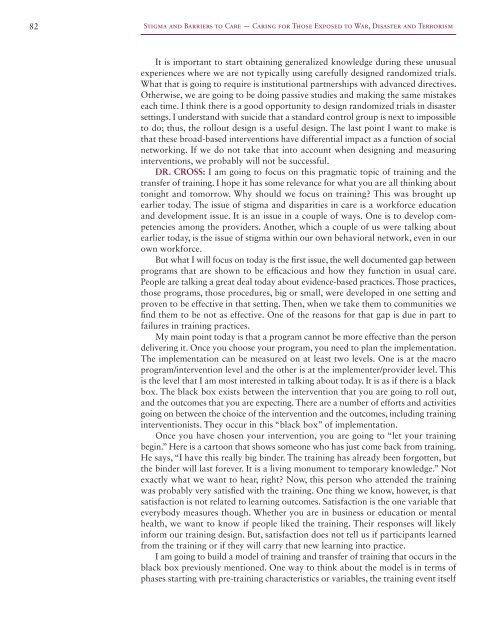stigma and barriers to care - Uniformed Services University of the ...
stigma and barriers to care - Uniformed Services University of the ...
stigma and barriers to care - Uniformed Services University of the ...
You also want an ePaper? Increase the reach of your titles
YUMPU automatically turns print PDFs into web optimized ePapers that Google loves.
82<br />
Stigma <strong>and</strong> Barriers <strong>to</strong> Care — Caring for Those Exposed <strong>to</strong> War, Disaster <strong>and</strong> Terrorism<br />
It is important <strong>to</strong> start obtaining generalized knowledge during <strong>the</strong>se unusual<br />
experiences where we are not typically using <strong>care</strong>fully designed r<strong>and</strong>omized trials.<br />
What that is going <strong>to</strong> require is institutional partnerships with advanced directives.<br />
O<strong>the</strong>rwise, we are going <strong>to</strong> be doing passive studies <strong>and</strong> making <strong>the</strong> same mistakes<br />
each time. I think <strong>the</strong>re is a good opportunity <strong>to</strong> design r<strong>and</strong>omized trials in disaster<br />
settings. I underst<strong>and</strong> with suicide that a st<strong>and</strong>ard control group is next <strong>to</strong> impossible<br />
<strong>to</strong> do; thus, <strong>the</strong> rollout design is a useful design. The last point I want <strong>to</strong> make is<br />
that <strong>the</strong>se broad-based interventions have differential impact as a function <strong>of</strong> social<br />
networking. If we do not take that in<strong>to</strong> account when designing <strong>and</strong> measuring<br />
interventions, we probably will not be successful.<br />
DR. CROSS: I am going <strong>to</strong> focus on this pragmatic <strong>to</strong>pic <strong>of</strong> train ing <strong>and</strong> <strong>the</strong><br />
transfer <strong>of</strong> training. I hope it has some relevance for what you are all thinking about<br />
<strong>to</strong>night <strong>and</strong> <strong>to</strong>morrow. Why should we focus on training This was brought up<br />
earlier <strong>to</strong>day. The issue <strong>of</strong> <strong>stigma</strong> <strong>and</strong> disparities in <strong>care</strong> is a workforce education<br />
<strong>and</strong> development issue. It is an issue in a couple <strong>of</strong> ways. One is <strong>to</strong> develop competencies<br />
among <strong>the</strong> providers. Ano<strong>the</strong>r, which a couple <strong>of</strong> us were talking about<br />
earlier <strong>to</strong>day, is <strong>the</strong> issue <strong>of</strong> <strong>stigma</strong> within our own behavioral network, even in our<br />
own workforce.<br />
But what I will focus on <strong>to</strong>day is <strong>the</strong> first issue, <strong>the</strong> well documented gap between<br />
programs that are shown <strong>to</strong> be efficacious <strong>and</strong> how <strong>the</strong>y function in usual <strong>care</strong>.<br />
People are talking a great deal <strong>to</strong>day about evidence-based practices. Those practices,<br />
those programs, those procedures, big or small, were developed in one setting <strong>and</strong><br />
proven <strong>to</strong> be effective in that setting. Then, when we take <strong>the</strong>m <strong>to</strong> communities we<br />
find <strong>the</strong>m <strong>to</strong> be not as effective. One <strong>of</strong> <strong>the</strong> reasons for that gap is due in part <strong>to</strong><br />
failures in training practices.<br />
My main point <strong>to</strong>day is that a program cannot be more effective than <strong>the</strong> person<br />
delivering it. Once you choose your program, you need <strong>to</strong> plan <strong>the</strong> implementation.<br />
The implementation can be measured on at least two levels. One is at <strong>the</strong> macro<br />
program/intervention level <strong>and</strong> <strong>the</strong> o<strong>the</strong>r is at <strong>the</strong> implementer/provider level. This<br />
is <strong>the</strong> level that I am most interested in talking about <strong>to</strong>day. It is as if <strong>the</strong>re is a black<br />
box. The black box exists between <strong>the</strong> intervention that you are going <strong>to</strong> roll out,<br />
<strong>and</strong> <strong>the</strong> outcomes that you are expecting. There are a number <strong>of</strong> efforts <strong>and</strong> activities<br />
going on between <strong>the</strong> choice <strong>of</strong> <strong>the</strong> intervention <strong>and</strong> <strong>the</strong> outcomes, including training<br />
interventionists. They occur in this “black box” <strong>of</strong> implementation.<br />
Once you have chosen your intervention, you are going <strong>to</strong> “let your training<br />
begin.” Here is a car<strong>to</strong>on that shows someone who has just come back from training.<br />
He says, “I have this really big binder. The training has already been forgotten, but<br />
<strong>the</strong> binder will last forever. It is a living monument <strong>to</strong> temporary knowledge.” Not<br />
exactly what we want <strong>to</strong> hear, right Now, this person who attended <strong>the</strong> training<br />
was probably very satisfied with <strong>the</strong> training. One thing we know, however, is that<br />
satisfaction is not related <strong>to</strong> learning outcomes. Satisfaction is <strong>the</strong> one variable that<br />
everybody measures though. Whe<strong>the</strong>r you are in business or education or mental<br />
health, we want <strong>to</strong> know if people liked <strong>the</strong> training. Their responses will likely<br />
inform our training design. But, satisfaction does not tell us if participants learned<br />
from <strong>the</strong> training or if <strong>the</strong>y will carry that new learning in<strong>to</strong> practice.<br />
I am going <strong>to</strong> build a model <strong>of</strong> training <strong>and</strong> transfer <strong>of</strong> training that occurs in <strong>the</strong><br />
black box previously mentioned. One way <strong>to</strong> think about <strong>the</strong> model is in terms <strong>of</strong><br />
phases starting with pre-training characteristics or variables, <strong>the</strong> training event itself




